Oldfield Park Junior School (Bath) WW1 Memorial Project
Walcot Parish (Bath) WW1 Memorial
in St Swithin's Church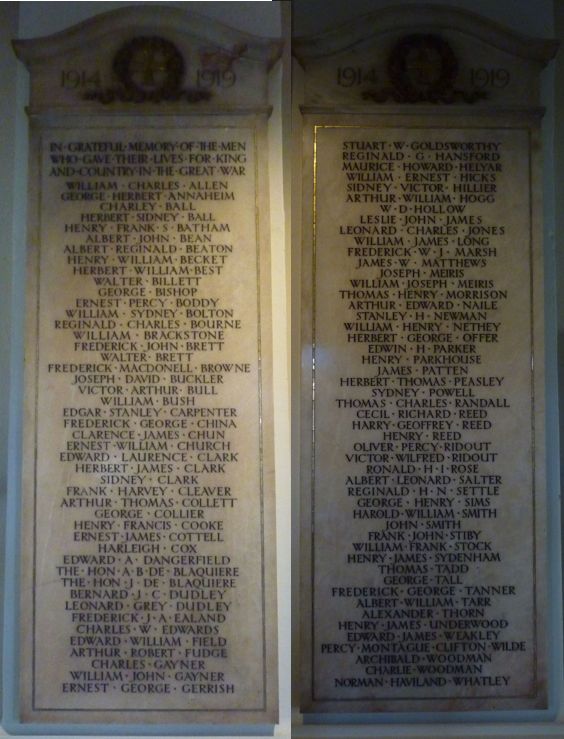
The Walcot Parish Memorial takes the form of a pair of marble tablets inside the body of the parish church of St. Swithin. They are mounted on the back wall of the church; one each side of the main door. The church is often open during the day, especially when its cafe is open in the crypt. It can be accessed around scheduled service times (with the usual respect for people preparing for service etc.) or other events and the church website is the best resource for knowing when these take place.
The church itself stands on a road junction which is thought to have been at the centre of the main Roman town of Aquae Sulis; certainly major Roman roads converged here.
The history of the WW1 memorial is described in the following contemporary news articles, which make it clear that memorial tablets were displayed in both Walcot Parish Church (St Swithin's) and St Andrew's church. St Andrew's stood immediately behind the Royal Crescent where there is now a triangle of grass, but was critically damaged in the Bath Blitz of April 1942 and subsequently demolished. We assume that the memorial in that church was destroyed in the bombing.
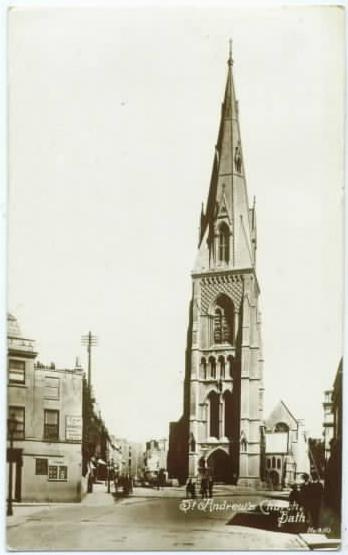

The church of St Andrew's which formerly stood behind the Royal Crescent
From Bath Chronicle & Weekly Gazette, Saturday 15th March 1919:
WALCOT WAR MEMORIAL
TABLETS IN TWO CHURCHES SUGGESTED
Two
meetings to discuss the form of the Walcot parochial war memorial were
held on Tuesday afternoon and evening in the St Andrew's Church Hall*. At the afternoon meeting the Rector (the Rev. C. W. Wilson) presided over a good attendance.
The Rector said they felt it would not be desirable to provide any new building, such as an institute or church, because they considered that any such buildign schemes would be met by the provision of the public war memorial. But they felt that in their own parish they should endeavour to commemorate the devotion and the bravery of those men who had gone out to fight their battles by provising a memorial. They thought it would be appropriate to erect in their church a tablet with the names inscribed upon it of those who had fallen in the war. The Rector pointed out that a number of those who had fallen were not members of their congregation, but had been in their Sunday schools or Bible classes. He had also received a number of letters from relatives of those who had fallen who were at one time resident in their parish. He thought it would be desirable to record for the information of posterity the names of all the men who went from Walcot parish to take their part in the war. He invited suggestions from the meeting.
Mr F. Ridge (churchwarden) thought that one of the charms of the interior of St Andrew's was the comparative absence of memorial tablets.
Dr. Gervis thought any memorial tablet selected should be executed in brass in preference to marble.
A parishioner asked if a memorial would be erected in each of the churches in the parish, and the Rector said this was one of the points he wished to decide.
Mrs. Wilson thought the list of men who had served should be placed in the porch; and the names of those who had perished should be recorded in the building.
Colonel W. E. Dudley thought the tower of St Andrew's Church would be a suitable place for the memorial.
Mr. E. A. Bagshawe (churchwarden) hoped the parishioners would erect a war memorial pure and simple and not beguile themselves by getting something done under the guise of a memorial which they wanted for other reasons (hear, hear). There were two very fine sites in St. Andrew's Church for such a memorial as he approved - a memorial of quite a definite character for those who had fallen. He did not think that St. Thomas's Chapel should be included in the scheme, as that was not a freehold property. He recommmended the appointment of a committee to deal with the proposal.
The meeting signified its approval of the general scheme for a parochial memorial; and decided in favour of the erection of tablets in both churches - St. Swithin's & St. Andrew's.
The Rector invited the gathering to nominate a committee of ladies and gentlemen to further the scheme; and those appointed were the Rector and churchwardens, Colonel Tredway Clarke, Colonel Dudley and Mr. Robertson, Mrs. Cecil Wilson, Mrs. Preston King, Mrs. Wilson Smith, Mrs. Brown, Miss Heard and Miss Murray.
The Rector then appealed for increased support for foreign missions, represented in Walcot parish by the maintenance of a lady missionary.
At the conclusion of the meeting refreshments were served.
The meeting in the evening was crowded and enthusiastic, and the attendance includede a large number of men. The proposals put forward in the afternoon were cordially ratified; and several additions were made to the memorial sub-Committee. The additional members are Lord de Blaquiere and Messrs. Bromfield, Cox, Kemmery, Head, and Newman.
The Rector said they felt it would not be desirable to provide any new building, such as an institute or church, because they considered that any such buildign schemes would be met by the provision of the public war memorial. But they felt that in their own parish they should endeavour to commemorate the devotion and the bravery of those men who had gone out to fight their battles by provising a memorial. They thought it would be appropriate to erect in their church a tablet with the names inscribed upon it of those who had fallen in the war. The Rector pointed out that a number of those who had fallen were not members of their congregation, but had been in their Sunday schools or Bible classes. He had also received a number of letters from relatives of those who had fallen who were at one time resident in their parish. He thought it would be desirable to record for the information of posterity the names of all the men who went from Walcot parish to take their part in the war. He invited suggestions from the meeting.
Mr F. Ridge (churchwarden) thought that one of the charms of the interior of St Andrew's was the comparative absence of memorial tablets.
Dr. Gervis thought any memorial tablet selected should be executed in brass in preference to marble.
A parishioner asked if a memorial would be erected in each of the churches in the parish, and the Rector said this was one of the points he wished to decide.
Mrs. Wilson thought the list of men who had served should be placed in the porch; and the names of those who had perished should be recorded in the building.
Colonel W. E. Dudley thought the tower of St Andrew's Church would be a suitable place for the memorial.
Mr. E. A. Bagshawe (churchwarden) hoped the parishioners would erect a war memorial pure and simple and not beguile themselves by getting something done under the guise of a memorial which they wanted for other reasons (hear, hear). There were two very fine sites in St. Andrew's Church for such a memorial as he approved - a memorial of quite a definite character for those who had fallen. He did not think that St. Thomas's Chapel should be included in the scheme, as that was not a freehold property. He recommmended the appointment of a committee to deal with the proposal.
The meeting signified its approval of the general scheme for a parochial memorial; and decided in favour of the erection of tablets in both churches - St. Swithin's & St. Andrew's.
The Rector invited the gathering to nominate a committee of ladies and gentlemen to further the scheme; and those appointed were the Rector and churchwardens, Colonel Tredway Clarke, Colonel Dudley and Mr. Robertson, Mrs. Cecil Wilson, Mrs. Preston King, Mrs. Wilson Smith, Mrs. Brown, Miss Heard and Miss Murray.
The Rector then appealed for increased support for foreign missions, represented in Walcot parish by the maintenance of a lady missionary.
At the conclusion of the meeting refreshments were served.
The meeting in the evening was crowded and enthusiastic, and the attendance includede a large number of men. The proposals put forward in the afternoon were cordially ratified; and several additions were made to the memorial sub-Committee. The additional members are Lord de Blaquiere and Messrs. Bromfield, Cox, Kemmery, Head, and Newman.
Bath Chronicle & Weekly Gazette, Saturday 13th March 1920
WALCOT WAR MEMORIALS
TABLETS IN ST. SWITHIN'S AND ST. ANDREWS
PAROCHIAL WAR MEMORIALS
PAROCHIAL WAR MEMORIALS
The
Rector described the progress which had been made with teh war memorial
scheme. It was proposed to place a memorial tablet St. Andrew's Church
on the south side of the chancel above the strong course. It was also
proposed to place two tablets of simpler design in the parish church.
These tablets would be of alabaster, as marble had proved unobtainable.
Some 920 parishioners had served, and 92 had perished.
It had proved impracticable to place on record in sculptured form the names of all who had served; and it was intended to record only the names of the fallen. The estimated cost of the tablets in the two churches was £400. The design of the tablet in St. Andrew's Church would consist of a standing figure of St. George in the centre, flanked on either side by two panels bearing the names of the fallen. The Rector explained that the amount so far hand was a little over £100. Lord de Blaquiere intended to erect a tablet in St. Andrew's Church to the memory of his two sons who perished in the war, and a fifth tablet was to be erected to the memory of an old worshipper at the parish church (Mr. Walmesley). The Rector hoped the erection of the memorials would be speedily taken in hand. They did not want to wait till there had been another war.
Mr. E. A Bagshawe appealed for early contributions to the fund, as this would enable them to apply more promptly for the necessary faculty. The Rector explained he hoped to compile a list of the men who had served which might be placed in the church as a permanent record. He was anxious to keep faith with those parishioners who had subscribed to the memorial fund, expecting that the names of their relatives who had served would be recorded. The Rev. H. Barton had taken great pains to compile a list of the names. He did not believe there was another parish in Bath, indeed in the diocese, which had so complete a record. The cost of this volume would be in addition to the amount needed for the memorial tablets.
It was resolved, without discussion, to apply for the necessary faculty.
Sketches of the designs of the war memorial tablets were exhibited at the meeting. The St. Andrew's memorial is the design of Messrs. Powell, of London, who have executed other memorials in this church. At the base of the central figure of St. George appear the words: 'To the honoured memory of the men of this parish who gave their lives for King and country in the Great War, 1914-1919.'
In the evening the Rector addressed another meeting at the Walcot Church Hall. The room was crowded, and the audience included a large number of men. The memorial proposals were enthusiastically adopted.
It had proved impracticable to place on record in sculptured form the names of all who had served; and it was intended to record only the names of the fallen. The estimated cost of the tablets in the two churches was £400. The design of the tablet in St. Andrew's Church would consist of a standing figure of St. George in the centre, flanked on either side by two panels bearing the names of the fallen. The Rector explained that the amount so far hand was a little over £100. Lord de Blaquiere intended to erect a tablet in St. Andrew's Church to the memory of his two sons who perished in the war, and a fifth tablet was to be erected to the memory of an old worshipper at the parish church (Mr. Walmesley). The Rector hoped the erection of the memorials would be speedily taken in hand. They did not want to wait till there had been another war.
Mr. E. A Bagshawe appealed for early contributions to the fund, as this would enable them to apply more promptly for the necessary faculty. The Rector explained he hoped to compile a list of the men who had served which might be placed in the church as a permanent record. He was anxious to keep faith with those parishioners who had subscribed to the memorial fund, expecting that the names of their relatives who had served would be recorded. The Rev. H. Barton had taken great pains to compile a list of the names. He did not believe there was another parish in Bath, indeed in the diocese, which had so complete a record. The cost of this volume would be in addition to the amount needed for the memorial tablets.
It was resolved, without discussion, to apply for the necessary faculty.
Sketches of the designs of the war memorial tablets were exhibited at the meeting. The St. Andrew's memorial is the design of Messrs. Powell, of London, who have executed other memorials in this church. At the base of the central figure of St. George appear the words: 'To the honoured memory of the men of this parish who gave their lives for King and country in the Great War, 1914-1919.'
In the evening the Rector addressed another meeting at the Walcot Church Hall. The room was crowded, and the audience included a large number of men. The memorial proposals were enthusiastically adopted.
From Bath Chronicle & Weekly Gazette, 3rd December 1921:
ST. ANDREW'S PARISH.*
WAR MEMORIAL UNVEILED.
NINETY NAMES RECORDED ON THE TABLET.
WAR MEMORIAL UNVEILED.
NINETY NAMES RECORDED ON THE TABLET.
It was a great service, long to be remembered by all who were present, which took place at St. Andrew's Church, Walcot, on Sunday.afternoon, the occasion being the unveiling of the handsome memorial which has been placed in the church in memory of, and to record the sacrifice made by, the 90 men associated with the parish who fought in the Great War. Every seat in the building was occupied, and the spirit which pervaded the service was one of deep reverence. As the names of the fallen were read out those most nearly and dearly concerned were deeply touched by the solemnity of the moment and the memory of loved ones who had died that others might live. The service was conducted by the Rector (Preb. Cecil W. Wilson), assisted by the Revs. F. Hardy, F. E. Compton and H. C. Wooldridge. The Rector performed the unveiling ceremony.
The hymns sung were 'The Saints of God', and 'For all the Saints who from their labours rest.' After the roll had been called, Bugler Major Wiltshire and Sergt.-Major Wiltshire sounded the 'Last Post', and at the conclusion of the address 'The Reveille', while, as the congregation filed out after the singing of the National Anthem, the organist (Mr. H. T. Head) played Chopin's Funeral March.
The memorial, which is executed in alabaster, is a magnificent piece of work. Fixed on the south wall of the chancel it consists of a canopied head piece which surmounts three panels. The two on the outside bear the names of the fallen men, while in the central panel is a figure in mosaic of St. George, the patron Saint of England. The wording immediately beneath the moulded canopy reads, 'They rest from their labours, and their works do follow them'.
The address by the Rector was based on the words, 'And everyone that hath forsaken houses, or brethren, or sisters, or father, or mother, or wife, or children, or lands, for My name's sake, shall receive an hundredfold, and shall inherit everlasting life" (St. Matthew, 19c., 29v.).
*St Andrew's was not a parish in its own right, but a subsidiary church of St. Swithin's Parish, Walcot.
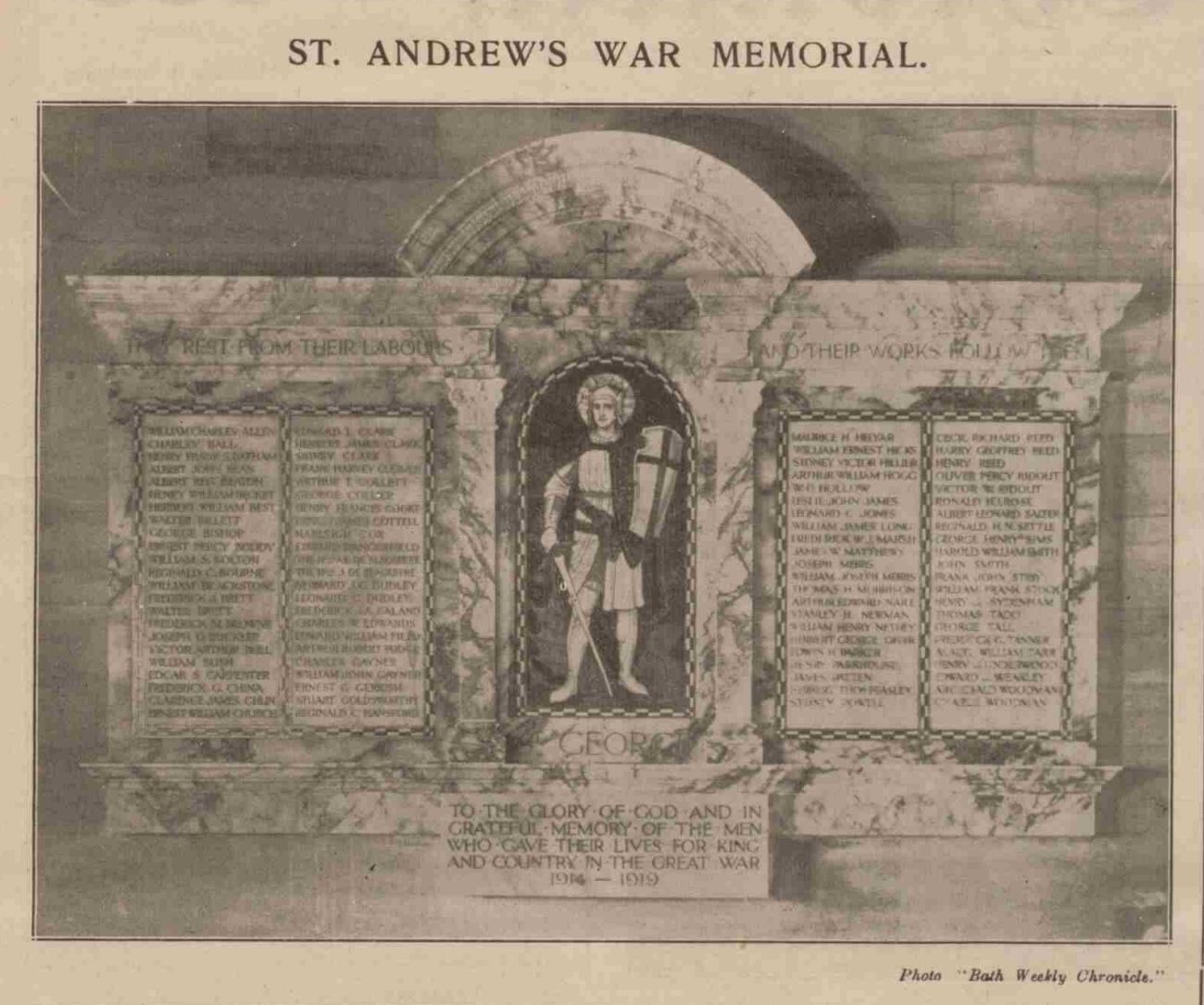
The article relating to the later dedication of the St. Swithin's memorial in May 1922 was very brief. From the Bath Chronicle & Weekly Gazette, Saturday 13th May 1922:
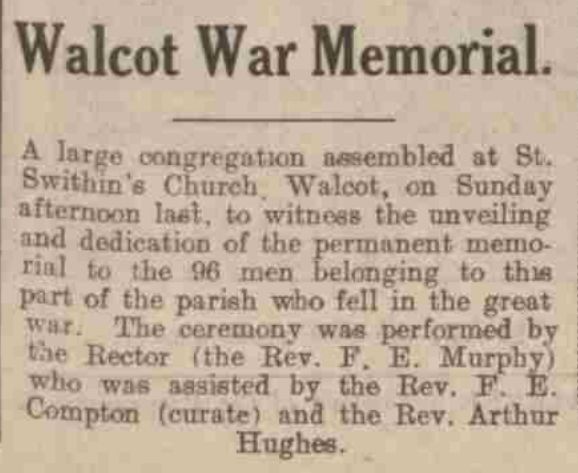
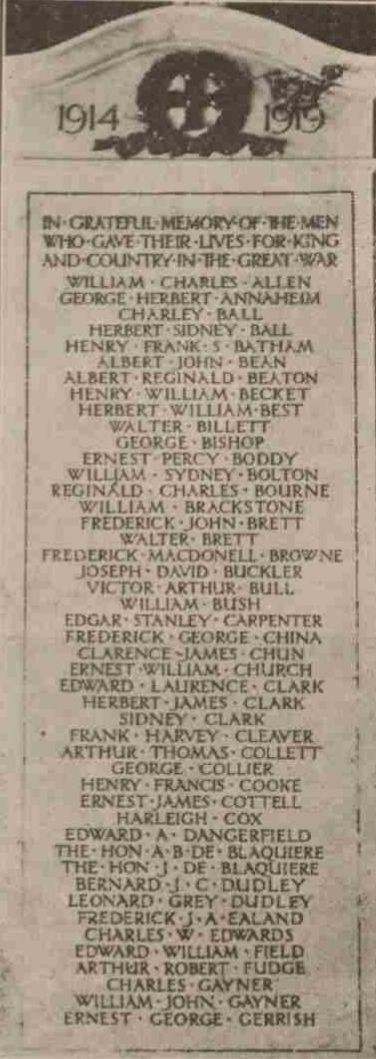
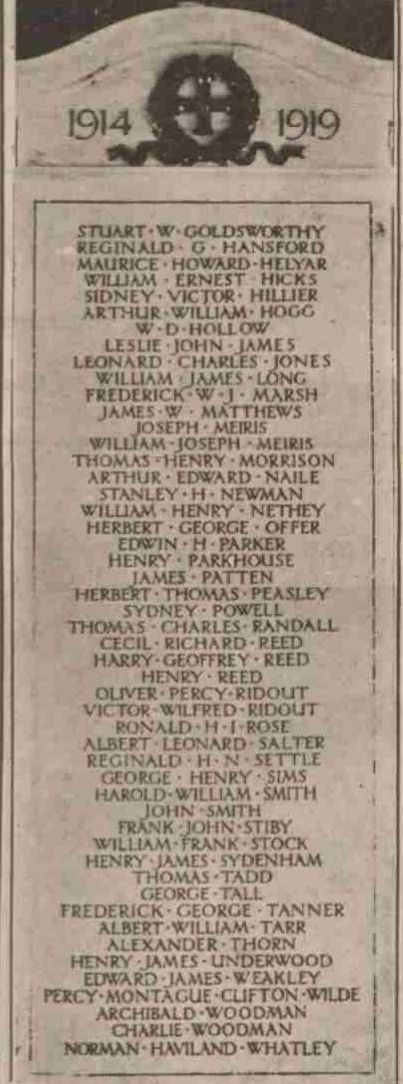
To assist anyone researching Bath's fallen servicemen, the wording and names of those commemorated on the tablets are as follows:
1914-1919
In grateful memory of the men
who gave their lives for King
and Country in the Great War
In grateful memory of the men
who gave their lives for King
and Country in the Great War